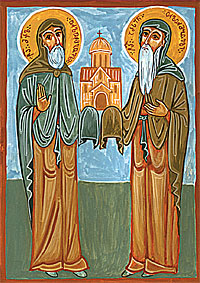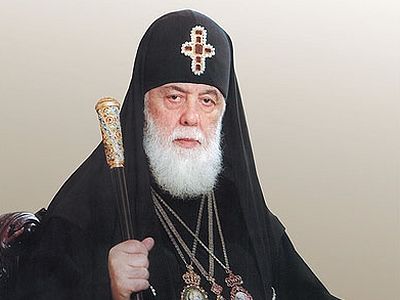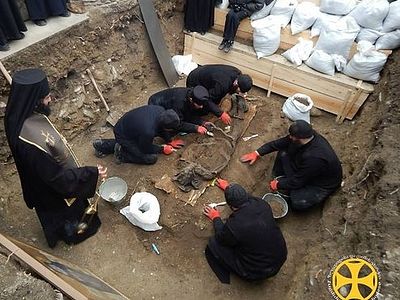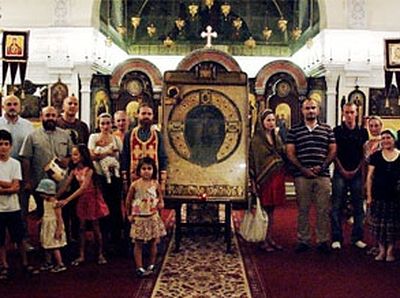Memory 7 (20) May
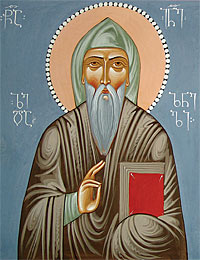 St. Ioane of Zedazeni
St. Ioane of Zedazeni
|
| St. Ioane of Zedazeni |
Our Holy Father Ioane of Zedazeni and his twelve disciples, Abibos of Nekresi, Anton of Martqopi, Davit of Gareji, Zenon of Iqalto, Tadeos of Stepantsminda, Ise of Tsilkani, Ioseb of Alaverdi, Isidore of Samtavisi, Mikael of Ulumbo, Piros of Breti, Stepane of Khirsa, and Shio of Mgvime, were Syrian ascetics and the founding fathers of Georgian monastic life. St. Ioane received his spiritual education in Antioch. Early in his youth he was tonsured a monk and withdrew to the wilderness. The Lord, recognizing his humility, diligence in fasting, and devout watchfulness, blessed His faithful servant with the gift of healing the sick and casting out demons. St. Ioane was celebrated for his holy deeds and miracles. Curious crowds would swarm around him, and after some time he found it necessary to withdraw into even deeper seclusion. Taking with him several of his disciples, he chose a remote area, fashioned for himself a cell, and began to labor as a hermit.
Once the Most Holy Theotokos appeared to St. Ioane and told him, “Take twelve monks and go with them to Georgia, the nation enlightened by the Equal-to-the-Apostles Nino, and strengthen the Christian soul of its people.” Saint Ioane related the vision to his disciples, and after much fasting and prayer he chose twelve of them: Abibos, Anton, Davit, Zenon, Tadeos, Ise, Ioseb, Isidore, Mikael, Piros, Stepane, and Shio. He left his remaining disciples in the wilderness in the care of the abbot, the blessed elder Ekvtime, and set off for Georgia with the twelve he had chosen.
By divine revelation the Georgian king Parsman and Catholicos Evlavios received the good news that the venerable fathers were in Mesopotamia, on their way to Georgia, and they hurried to greet them with the proper honors. King Parsman and Catholicos Evlavios met the holy fathers as they were approaching Mtskheta.
The holy fathers venerated the myrrh-streaming wood of the Living Pillar and the Robe of Christ at Svetitskhoveli Cathedral. From there St. Ioane and his disciples traveled throughout Georgia, visiting its many holy sites.
With the blessing of Catholicos Evlavios, St. Ioane and his disciples settled on Zedazeni Mountain, where a pagan temple to the idol Zadeni had previously stood. The monks lived in wretched cells, eating only plants and praying ceaselessly.
Having heard of the spiritual endeavors of St. Ioane and his disciples, Christian believers began to flock to Zedazeni Mountain. Many burned with longing for the monastic life, and some abandoned the world to join the holy fathers at Zedazeni. In such a way, Zedazeni Mountain was transformed into an abode of hermits.
One night the Most Holy Theotokos appeared again to St. Ioane and instructed him to send his disciples throughout the country to preach the Word of God. In the morning, having related the vision to his disciples, St. Ioane advised them: “Our Lord Jesus Christ sent us to perform good deeds for this country and its people, for they are newly planted seeds in the Christian Faith. Therefore, let us go forth, each in his own direction, to preach the Word of God!”
St. Ioane remained at Zedazeni and went about his usual labors in the company of the Deacon Ilia. Zedazeni Mountain was without water, but St. Ioane prayed to God for a spring, and the Lord sent him a healing spring at the mountain’s peak. Through St. Ioane’s holy prayers, a bear that often came to the spring to drink was tamed and became a guard and protector of ZedazeniMonastery. (To this day, the beasts of Zedazeni forest have never disturbed a single soul). Through St. Ioane’s intercessions, a man mute and paralyzed from his childhood began to speak and walk.
After earnestly serving God for many years, St. Ioane received a sign that his death was approaching. He called his disciples, blessed them, bade them farewell, and left them to bury him in the cave where he had dwelt. After receiving Holy Communion, St. Ioane beheld the heavens open and the incorporeal powers with the armies of saints shining forth. The Lord called St. Ioane toHimself, saying: “I am the Lord, theGod of your fatherAbraham. Comeand I will give you rest fromyour labors.” The holy father prayed and gave up his soul to the Lord.
After his repose St. Ioane’s disciples reasoned among themselves that a dismal cave was unfit to serve as their holy father’s burial place, and with great reverence they buried his remains in a church at the foot of the mountain. But suddenly a violent earthquake shook the ground where they stood. The earth ceased to quake only after the frightened disciples remembered their shepherd’s will and realized that the tremors were a sign from God. So the disciples, a priest, and a deacon uncovered the holy relics and reburied St. Ioane according to his will. While they were being translated, St. Ioane’s holy relics healed many sick and demon-possessed people.
In the 10th century, during the time of Catholicos Clement (908–923), a church in honor of St. John the Baptist was built on the south side of St. Ioane’s cave. The holy father’s grave is located near the altar of this church.
The Holy Martyr Abibos of Nekresi was consecrated bishop of Nekresi at the request of Parsman VI, King of Kartli, and Catholicos Evlavios. Filled with holy zeal, Bishop Abibos converted many pagans to the Christian Faith.
In the 6th century the Persians forced many Georgians to deny Christ and worship fire in accordance with their own custom. When St. Abibos poured water on their altar of sacrifice to extinguish the “holy fire,” the enraged Persians beat him cruelly, then stoned him to death. By order of the marzban (Persian viceroy), the holy relics of Martyr Abibos remained for three days under the open sky. But to the marzban’s great amazement, neither beast nor bird would touch them. On the fourth night, monks from Rechi Monastery arrived and translated the holy relics to SamtavisiMonastery for proper burial. Later, by order of Stepanoz (600–619), the rightful ruler of Kartli, the holy relics of St. Abibos were translated again, to Samtavro Monastery in Mtskheta, and buried in the sanctuary under the altar table.
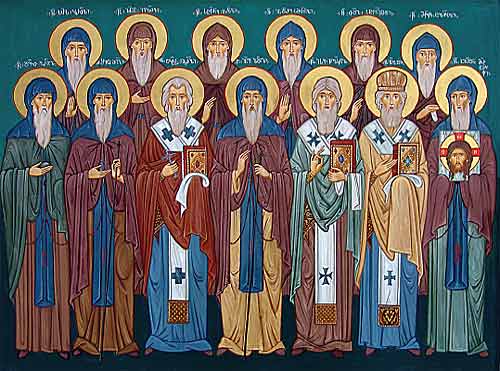 The Holy Thirteen Syrian Fathers. Front row: Davit of Gareji, Shio of Mgvime,
The Holy Thirteen Syrian Fathers. Front row: Davit of Gareji, Shio of Mgvime,
|
| The Holy Thirteen Syrian Fathers. Front row: Davit of Gareji, Shio of Mgvime, |
St. Anton of Martqopi always carried with him an icon of the Savior “Not-Made-By-Hands” which he had brought from Edessa in Asia Minor.
A lover of solitude, St. Anton settled in Lonoati Gorge, but the many curious Christians, drawn by his prayers and miracles, disturbed his seclusion. So the holy father built a monastery for his faithful followers, withdrew in reclusion beyond the Alazani River, and later settled on Akriani Mountain. In his new hermitage, he ate mostly plants and the bark of trees, and God sent a bear to bring him food. Later St. Anton erected a pillar at the top of the mountain and dwelt upon it for eighteen years.
The venerable father received a sign from God when his death was imminent, and at the moment of his repose he was kneeling in prayer before the icon of the Savior. His disciples carried his holy relics down from the pillar and buried them in the monastery he had founded, in front of the icon of the Mother of God.
St. Davit of Gareji first settled in the outskirts of Tbilisi, the new capital of Georgia. Through his wondrous preaching, St. Davit converted many fire-worshippers and brought people of many creeds to the Christian Faith.
One day the fire-worshippers took revenge: they bribed a pregnant woman to agree to their scheme and accuse St. Davit of adultery. But the wonder-worker St. Davit touched his staff to the woman’s womb and said, “In the name of the Lord Jesus Christ, I command you, infant, tell us who your real father is!” The infant uttered the name of his true father from inside his mother’s womb. The crowd of bystanders was outraged and began to stone the pagan slanderers. Deeply disturbed by the rioting and unable to stop the bloodshed, St. Davit departed with his disciple Lukiane.
Sts. Davit and Lukiane settled in the Gareji Wilderness in southeastern Georgia. The Lord provided them with food in abundance: every day, except Wednesdays and Fridays, a herd of deer came to visit them. Lukiane milked the animals, and when Davit made the sign of the Cross over the milk, it was miraculously transformed into cheese. News of the wonders performed by the holy fathers spread quickly, and soon the Gareji Wilderness became a refuge for the many Christians who hungered to lead a true ascetic life.
After some time a pious monk called Dodo came from Ninotsminda, a village in eastern Georgia, and, having received a blessing from his spiritual father, established the Monastery of the Most Holy Theotokos on the eastern side of the Gareji mountains. Since that time the eastern range has been called “Dodo’s Range.”
St. Davit went to Jerusalem on pilgrimage, but when he arrived there, he suddenly judged himself unworthy and dared not enter the gates of the city. He prayed fervently before the city gates, then, in his profound humility, chose three stones to take with him as treasures and departed. That same night an angel appeared to Patriarch Elias of Jerusalem and told him that a monk named Davit, who had arrived from Georgia, was taking away all the grace of the Holy Land. The patriarch’s messengers found St. Davit and seized from him two of the stones. The third stone he carried back to Gareji Monastery.
Having served the Lord his whole life, through much suffering and many tribulations, the God-pleasing St. Davit reposed peacefully and was buried at Davit-Gareji Monastery.
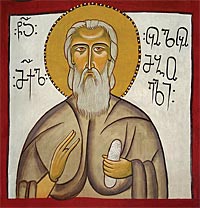 St. Mikael of Ulumbo, one of St. Ioane’s disciples.
St. Mikael of Ulumbo, one of St. Ioane’s disciples.
|
| St. Mikael of Ulumbo, one of St. Ioane’s disciples. |
St. Ise of Tsilkani was consecrated bishop of Tsilkani by Catholicos Evlavios, at the suggestion of St. Ioane of Zedazeni. The holy father preached to many crowds and converted many unbelievers. Before long, many followers had gathered around him. St. Ise, like St. Ioane’s other disciples, was endowed with the ability to work miracles.
Once St. Ioane decided to test the faith of his disciples, and he required each of them to perform a miracle. When it was St. Ise’s turn, he descended to the Ksani River, crossed over it, then touched his staff to the water and cried out, “In the name of the Lord, I command you to follow me!” Immediately the river began to flow in the opposite direction, and it followed every move of the venerable father’s staff. St. Ise led the river to Tsilkani Monastery.
Having witnessed this miracle, many people were converted to the true Faith.
St. Ise received a sign from heaven when his repose was near. He partook of the Holy Gifts and prayerfully gave up his soul to God. St. Ise is buried in the Tsilkani Church of the Most Holy Theotokos. St. Ioseb of Alaverdi always carried with him a cross that had been formed from the wood of the Life-giving Cross of our Savior.With the blessing of his teacher, St. Ioseb preached the Gospel of Christ throughout the region of Kartli in eastern Georgia and later settled in the Alaverdi Wilderness.
Once St. Ioseb encountered a pagan nobleman and preached to him the Word of God. Deeply inspired by Fr. Ioseb’s grace-filled preaching, the nobleman founded a monastery in Alaverdi. Villagers from the surrounding region heard about the holy father’s great spiritual feats, and many of them left the world to labor with him. The number of ascetics in the region began to increase steadily from that time.
When his long and labor-filled life was drawing to an end, St. Ioseb appointed a new abbot for the monastery and reposed peacefully in the Lord. To this day many miracles have taken place over his grave at Alaverdi Monastery.
From his youth St. Shio of Mgvime (of the cave) was a disciple of St. Ioane of Zedazeni, and he followed him to Georgia. St. Shio settled in Sarkineti, a region northwest of Mtskheta. The Most Holy Theotokos blessed the monk, and he carried out his labors in accordance with her revelations.
A dove would bring food to the blessed father, and St. Evagre (at that time the ruler of Tsikhedidi) witnessed this miracle one day while hunting in the area. Deeply inspired by his unceasing labors, the prince left the world to become St. Shio’s disciple. It was not long before St. Shio’s wilderness was filled with people who longed for the ascetic life. St. Shio founded a monastery in Sarkineti, gathered nearly two thousand monks to labor there with him, and instructed them in a strict ascetic life.
Having performed countless miracles, St. Shio finally vowed to God that he would spend the remainder of his life in a well that he had dug for himself. He appointed Evagre abbot of the monastery and went into reclusion at the bottom of the well. There he spent fifteen years and reposed peacefully in the Lord. St. Shio’s holy relics are buried in that well, and to this day many miracles have taken place over his grave.
St. Piros of Breti, called the “Divine Image of Repentance,” founded a monastery in Breti, on the bank of the Jvaristsqali River. His holy relics are buried in the church at that monastery.
St. Isidore of Samtavisi preached the Christian Faith in Kartli for many years, in accordance with his teacher’s instruction. On the eastern bank of the Rekhula River, he founded Samtavisi Monastery of the Icon of the Savior “Not-Made-By-Hands.” He reposed and was buried at that monastery.
St. Tadeos of Stepantsminda first preached in Mtskheta, and later he founded a monastery at the foot of Zedazeni Mountain. After St. Ioane’s repose, St. Tadeos continued to preach throughout Kartli and erected many new churches. Among them, the Church of the Protomartyr Stephen in Urbnisi is a glorious example. Near the end of his life St. Tadeos withdrew to a cave at Tsleva Mountain not far from the city of Kaspi. He reposed peacefully and is buried in that place. St. Stepane of Khirsa and his companions preached throughout the region of Kakheti in eastern Georgia. Later St. Stepane founded Khirsa Monastery near Kharnabuji Castle. He is buried in the sanctuary of the Church of the Protomartyr Stephen at Khirsa.
St. Zenon of Iqalto preached the Christian Faith in northern Kakheti and founded Iqalto Monastery. He reposed peacefully, after accomplishing many good works on behalf of the true Faith. St. Zenon is buried at Iqalto in the Church of the Icon of the Savior “Not-Made- By-Hands.”
St. Mikael of Ulumbo preached the Christian Faith in northern Kartli and Ossetia. He founded a monastery in the Ulumbo[1] area, where his wonder-working relics were later buried.
Many Georgian children have been raised at the monasteries founded by the Thirteen Syrian Fathers. For centuries the Divine grace of the holy ascetics has spread among the Georgian people and throughout their land.
These monasteries and the holy fathers who founded them continue to protect the Georgian people against all manner of sin and unbelief.
O God-fearing and thrice-venerable Syrian Fathers, lift up your holy hands to the Heavenly King and pray that He grant peace to our nation, safety to all Christian people, and great mercy to all those who call upon His name!
[1]Ulumbo was named after Mt. Olympus (in old Georgian Mt. Olympus is known as Mt. Ulumbo), a center of monasticism in Bythinia, Asia Minor. See footnote on page 172.
